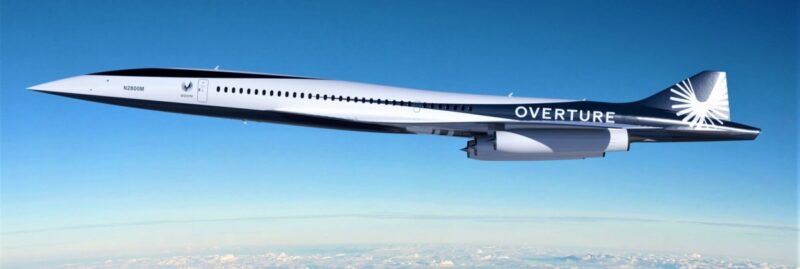Boom’s Overture supersonic jet will use quiet, low-emission engines

Being supersonic involves a lot more than a cool-looking aircraft. You need engines that can push the jet past Mach 1 (767.3 miles per hour, 1,268 km per hour). These days, any jet maker also needs to consider sustainability, reliability and lower noise levels—in other words, mitigating sonic booms—that made the Concorde famous, and in cities, infamous for breaking windows.
Boom says it has found a solution for its Overture jet with a new engine called Symphony. It has released a rendering and some technical data for the engine. These are more goals than current realities since it will be a clean-sheet design and five years before the Symphony-powered Overture makes its first test flight.
On paper, the Overture will be a Mach 1.7 (1,150 miles per hour, 1,850 km per hour) supersonic airliner with 4,250 nautical miles of range. Boom says the interior can be configured for 65 to 88 passengers and that there are 500 possible routes for the jet. It foresees an eventual market for 1,000 aircraft.
Symphony will be key to making the program work. “Through the Symphony program, we can provide our customers with an economically and environmentally sustainable supersonic airplane—a combination unattainable with the current constraints of derivative engines and industry norms,” said Boom’s founder and CEO Blake Scholl. Florida Turbine Technologies, GE Additive, and StandardAero were all named partners on the Symphony project.
The company said the new supersonic engine will operate at net-zero carbon levels and have reduced sound levels compared to existing supersonic engines. The engines, add Boom, will lower maintenance costs for companies like United Airlines that have made pre-orders.
Kratos’ Florida Turbine Technologies will lead the engine design. Its team will include engineers responsible for developing the F-119 and F-135 supersonic engines in the US Air Force’s F-22 and F-35 fighter jets. GE Additive will design engine components that are lighter and will allow for faster build times.
Symphony will be a medium-bypass turbofan engine with the same engine architecture powering modern commercial aircraft. But the new engine will have an axisymmetric supersonic intake, a variable-geometry low-noise exhaust nozzle and a passively cooled high-pressure turbine. It will also be designed to run on sustainable aviation fuel, which has 80 percent lower carbon emissions levels than Jet-A diesel. The single-stage fan is designed for quiet operation. It will produce 35,000 lbs at takeoff.
Boom says Symphony is already being designed, with production expected in 2024 at its facility in Greensboro, North Carolina. Overture’s first flight is anticipated for some time in 2027, with certification expected in 2029.
Boom is the only supersonic aircraft builder in the market, with competitor Aerion having closed its business last year. The Colorado-based firm has plugged steadily along since Scholl founded it in 2014. It currently has an ongoing test program of the supersonic demonstrator XB-1 in California, with flight tests expected early next year. The company said earlier this year it expects to break ground on a new campus in Greensboro by the end of this year. robbreport.com
